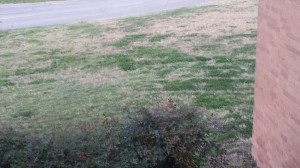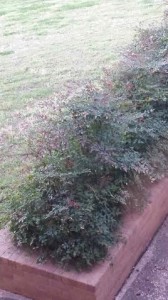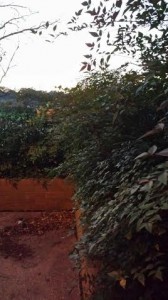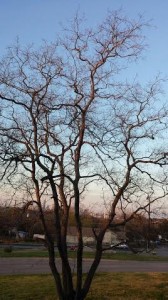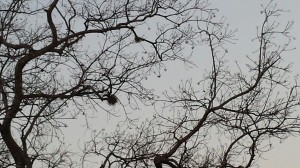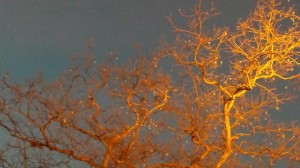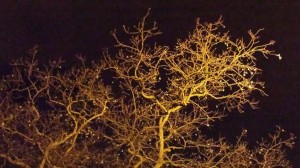Winter’s wrath has given this little spot more to deal with since my last entry. A couple more days of ferocious cold hit, bringing freezing winds, ice, and even a little snow. Much of that cold has been straining some of the outer branches of the “L” shaped bushes, clearing leaves from the outer layer. I was safe, I could watch from behind the glass and let the indoors “warm my shins while a February blizzard tosses the trees outside” (Leopold 6). That bitter cold kept up consecutively for a couple of days, but very slowly, spring whether started arriving. You could tell by the 75 degree heat and the shorts that people wore that the soothing, warmer weather was upon us. After more of this climate began to settle in, I checked on my spot to see its progress.
I was watching it towards evening hours and began to realize about half an hour into my observation, more had changed than I previously thought. When I first made it back to my spot I began taking pictures. “They look the same as last time,” I thought to myself. But I could not expect to see any major changes from battered bushes and a beaten down tree in about a month’s worth of time. It was about 6 pm with the weather at a very cool and steady 53 degrees Fahrenheit. No animals were roaming. Everything was completely silent, absolutely still, as if nature was winding down for the night just as my dorm does after a long school day. Then I thought “the devil is in the details.” Just as suspected there were small changes, signs of life. The bushes were sprouting small red berries. The grass was developing dark green patches in the background. The tree was slowly blooming small buds that looked to be the start of little white flowers. This scenery was looking somewhat lively again even in the stillness of the night.
Each time I observe my spot, I tend to end it with admiring the withered tree in the courtyard. For whatever reason, I am fascinated by its aged exterior. I begin to wonder, how long it has actually been there, what all happens to it in every other season, what is it housing deep it roots and interior; everything I cannot see. For whatever reason, in the midst of all this thought, I was reminded of the trees back home, outside my old high school. They looked pretty similar to this in the winter/spring transition and I was often around them a lot because I stayed late at school for theater rehearsals. I was a technician, and I guess staring at the way the light was hitting the tree here made me think of home. The tree began to look livelier as the evening began setting in within the hour. As it grew dark enough for the outside light to turn on, I heard “action!” in the back of my mind and saw how the different shades of the night were beautifully framing the tree. Once the lights hit, the tree caught fire, each of its branches turning into various shades of orange. Minutes passed and as the nightly background faded to a deep dark blue, the tree was enhanced to look yellow and white, almost angelic in my opinion. Those buds became beautiful, looking as what I could best describe as spring snow.
That calmed me to think of my home, my theater, the serenity I found in each. Just by looking at that tree, it made me more grateful for my home and the things that make me happy. I wanted to consider this entry a type of dedication to that tree, exploiting the many layers it hides behind its masked beauty. This whole scenery brought many memories back. A background of grass, the props of the bushes, the effects of the side lights, and the tree, the humbling star of the show: this area is its own miniature theater that I am continuously excited to see grow as I saw with the theater department at home. With the personal resonance I found in this quote, I do not believe Aldo Leopold could have described the theatrics of nature more beautifully: “the stage props, like the opening hour reflect the temperamental demands of the performer. The stage must be an open amphitheater in woods or brush and in its center there must be a mossy spot, a streak of sterile sand, and a bare outcrop of rock, or a bare roadway” (Leopold 30).
